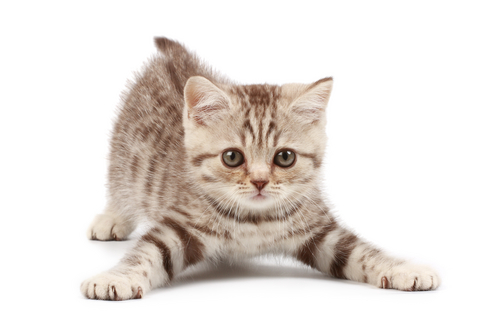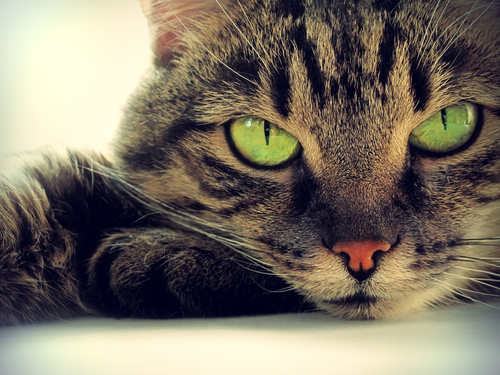Do You Know Why Cats Fight?

I’m sure you’ve often seen street fights between cats. Or even, if you have more than one cat, you may have experienced these fights in your own home and know it’s best to stay away. But why do cats fight?
Why do cats fight?
Cats can fight for a number of reasons, but these generally boil down to two: territorial fights and fights over a female. Cats are highly territorial and have a strong fighting instinct. If the fighting cats are your own, try to avoid territorial fights by providing separate litter and food bowls in different places in the house and make sure you give them both the same attention.
Fights between your cats should be stopped as soon as possible by using treats to reinforce good behavior. If the fight is with a stray, it usually occurs between unneutered cats that may have infectious diseases, which will aggravate their fights.
What are the types of aggressive behavior that cats can display?

Cats can exhibit different types of aggressive behavior.
If the aggression is territorial, the cat may be aggressive towards some cats and tolerant of others. Typical behavior for this type of aggression includes case, chasing, ambushing, snorting, and loud meowing, and the aggressor cat may even try to prevent the other cat from accessing places such as its litter box or bed. Although males appear to be more aggressive, female cats can be just as aggressive as males when it comes to territorial issues.
However, males may fight each other simply because they’re male, and they’ll fight for a female, for a higher place in the hierarchy, or to defend their territory. The fact that one cat is threatening another can be seen by the aggressor cat stalking the other, staring, and with an arched back and bristling fur. If the other cat doesn’t turn around, a fight will ensue.
A third form of aggression is defensive aggression. This occurs when a cat tries to protect itself from another animal or human that it thinks it can’t escape from. It can occur in the face of punishment or the threat of punishment by the owner, an attack or attempted attack by another cat, or any incident that causes the cat to feel threatened or frightened.
The defensive posture the cat adopts in these circumstances is to crouch down with its tail and paws under its body, flatten its ears against its skull, and roll slightly to one side. Approaching a cat in this posture may make it feel more threatened and cause an attack.
Cats may redirect their aggression against another animal or person, even if they didn’t provoke the attack, simply because they feel threatened or nervous. Even if your intention is to comfort the cat, he may be attacking you because it’s nervous about something else.
If your cat frequently attacks others, consult your veterinarian, as your cat may be sick and may be taking its stress out on others.
How do I separate two cats that are fighting?

Don’t even think of getting in the middle of the fight or touching them while they’re fighting, because you could get hurt. To separate two fighting cats, you should shout or clap your hands at them as close to the fight as possible, or use a jet of water against the cats.
In short, it should be something to distract their attention. Under no circumstances should you throw objects at the cats or physically hit or touch them, or they’ll think you want to participate in the fight. Once separated, you should get them to relax, and then console them separately.
Don’t count on your cats to solve their problems on their own. You should be the one to mediate between them, looking for the cause of the problem and finding solutions to prevent it from happening. Above all, when they fight, don’t touch or punish them, since you’ll only aggravate the fights. And, under no circumstances should you introduce more cats into your house.
I’m sure you’ve often seen street fights between cats. Or even, if you have more than one cat, you may have experienced these fights in your own home and know it’s best to stay away. But why do cats fight?
Why do cats fight?
Cats can fight for a number of reasons, but these generally boil down to two: territorial fights and fights over a female. Cats are highly territorial and have a strong fighting instinct. If the fighting cats are your own, try to avoid territorial fights by providing separate litter and food bowls in different places in the house and make sure you give them both the same attention.
Fights between your cats should be stopped as soon as possible by using treats to reinforce good behavior. If the fight is with a stray, it usually occurs between unneutered cats that may have infectious diseases, which will aggravate their fights.
What are the types of aggressive behavior that cats can display?

Cats can exhibit different types of aggressive behavior.
If the aggression is territorial, the cat may be aggressive towards some cats and tolerant of others. Typical behavior for this type of aggression includes case, chasing, ambushing, snorting, and loud meowing, and the aggressor cat may even try to prevent the other cat from accessing places such as its litter box or bed. Although males appear to be more aggressive, female cats can be just as aggressive as males when it comes to territorial issues.
However, males may fight each other simply because they’re male, and they’ll fight for a female, for a higher place in the hierarchy, or to defend their territory. The fact that one cat is threatening another can be seen by the aggressor cat stalking the other, staring, and with an arched back and bristling fur. If the other cat doesn’t turn around, a fight will ensue.
A third form of aggression is defensive aggression. This occurs when a cat tries to protect itself from another animal or human that it thinks it can’t escape from. It can occur in the face of punishment or the threat of punishment by the owner, an attack or attempted attack by another cat, or any incident that causes the cat to feel threatened or frightened.
The defensive posture the cat adopts in these circumstances is to crouch down with its tail and paws under its body, flatten its ears against its skull, and roll slightly to one side. Approaching a cat in this posture may make it feel more threatened and cause an attack.
Cats may redirect their aggression against another animal or person, even if they didn’t provoke the attack, simply because they feel threatened or nervous. Even if your intention is to comfort the cat, he may be attacking you because it’s nervous about something else.
If your cat frequently attacks others, consult your veterinarian, as your cat may be sick and may be taking its stress out on others.
How do I separate two cats that are fighting?

Don’t even think of getting in the middle of the fight or touching them while they’re fighting, because you could get hurt. To separate two fighting cats, you should shout or clap your hands at them as close to the fight as possible, or use a jet of water against the cats.
In short, it should be something to distract their attention. Under no circumstances should you throw objects at the cats or physically hit or touch them, or they’ll think you want to participate in the fight. Once separated, you should get them to relax, and then console them separately.
Don’t count on your cats to solve their problems on their own. You should be the one to mediate between them, looking for the cause of the problem and finding solutions to prevent it from happening. Above all, when they fight, don’t touch or punish them, since you’ll only aggravate the fights. And, under no circumstances should you introduce more cats into your house.
All cited sources were thoroughly reviewed by our team to ensure their quality, reliability, currency, and validity. The bibliography of this article was considered reliable and of academic or scientific accuracy.
- Arroyo, P. (2005) Métodos de esterilización en gatos. Anatomía aplicada de los pequeños animales. Recuperado el 29 de enero de 2022, disponible en: https://www.uco.es/organiza/departamentos/anatomia-y-anat-patologica/peques/curso01_05/esteriliza2.pdf
This text is provided for informational purposes only and does not replace consultation with a professional. If in doubt, consult your specialist.








